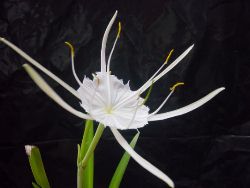Spider
Lily
Hymenocallis
caroliniana

Click
on picture for larger photo.
(24.4KB)
Photo by John Macke
Problems:
No serious insect or disease problems.
Snails, caterpillars and mealy bugs are occasional
visitors. At the end of the summer in 1998, many
spiderlilies were devoured by a swarm of caterpillars,
the larvae of the Xanthopastis
moth.
Hymenocallis
means "beautiful membrane" which refers to the
the corona that connects the stalks of the stamens
for a portion of their length. This is a large
spectacular flower that is exciting to find unexpectedly.
Synonymous
with and sometimes sold as Hymenocallis occidentalis.
Family:
Amaryllidaceae
Habit:
Bulb
Light: Full
sun to part shade.
Height: to 2 foot.
Spread:
1 to 1.5 feet
Booms:
May - August.
Water
Depth: Medium
wet to wet.
Maintenance:
Low
Hardy:
Zone 5 to 8
The
majority of the information on this page is from:
Missouri Botanical
Garden, Kemper
Center for Home Gardening.
|
Spider
Lilies are a native bulbous herbaceous
perennial
which occurs in swamps and moist woods in the south-eastern
U. S. It looks like a spidery daffodil with extremely
narrow perianth (petal-like) segments. It Features
a basal clump of up to 12 linear, strap-shaped,
amaryllis-like leaves, each to 17" long and
2 inches wide,
growing directly from a bulb.
Range:
Rare.
More
common in swampy areas of Georgia, Alabama, and
Arkansas, but range extends up the river valleys,
and reaches
its northern limit into southern Missouri,
Illinois, Kentucky and the southwestern corner of
Indiana.
Flowers:
In
summer, a solid scape to 24" tall rises from the
center of the foliage and is topped by an umbel
of 5-10 fragrant, white, spidery flowers (to 6"
across). Each flower has six (6) extremely narrow,
outward-spreading-to-reflexed perianth segments
and a daffodil-like staminal center cup (corona).
The
blooms first appear in mid summer and continue into
late summer. Flowers
are followed by oval to spherical seed capsules
with large bean-like seeds that should not be disturbed
in the wild.
Habitat:
Rich damp woods usually near water.
These
plants are rare in the wild and should never be
dug up for transplanting to a home garden.
General
Culture: Best
grown in medium wet to wet soils in full sun to
part shade. Soils must never be allowed to dry out.
May not be reliably winter hardy throughout USDA
Zone 5.
Landscape
Uses: Best
in moist open woodland gardens, bog gardens or along
streams and ponds. May be grown in a border as long
as the soil moisture requirements can be met.
|


